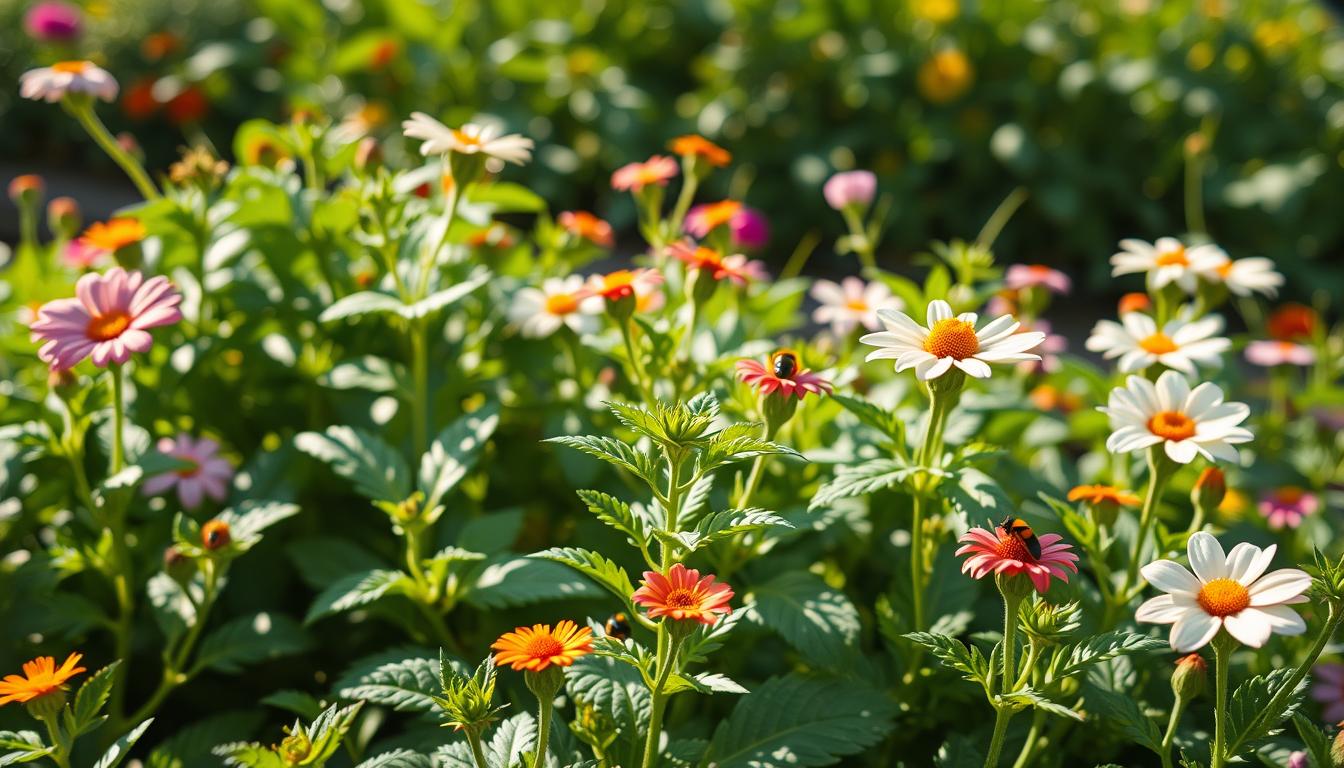As a gardener or farmer, managing pests and diseases is vital. It keeps plants healthy and boosts yields. Effective Pest and Disease Management is essential for a thriving farm or garden.
I’ll share tactics for managing pests and diseases. This includes the importance of integrated pest management. You’ll learn how to reduce pest and disease risks in your garden or farm.
With the right strategies, you can create a sustainable agricultural ecosystem. I’m excited to share my knowledge with you.
Understanding Pest and Disease Management
As a gardener or farmer, I know how vital it is to keep plants healthy. Pests and diseases can harm crops and lower yields. It’s key to manage these issues to stop disease spread and keep plants thriving. Pest control services offer expert advice and treatments to prevent infestations.
To manage pests and diseases well, it’s important to know what they are and how they affect plants. Pests are insects, mites, or small animals that eat plants. Diseases come from fungi, bacteria, or viruses. Both can damage plants, slowing their growth and reducing productivity.
What Are Pests and Diseases?
Pests and diseases come in many types, each with its own traits and signs. Common pests include aphids, whiteflies, and spider mites. Diseases can be caused by fungi like powdery mildew or root rot. Knowing the different types is crucial for effective management.
Importance in Agriculture and Gardening
In farming and gardening, managing pests and diseases is key to keeping plants healthy and stopping disease spread. Good management can cut down on chemical pesticide use, which is harmful to the environment and people. Natural pest control methods, like companion planting and crop rotation, help keep plants healthy while reducing pest and disease risks.
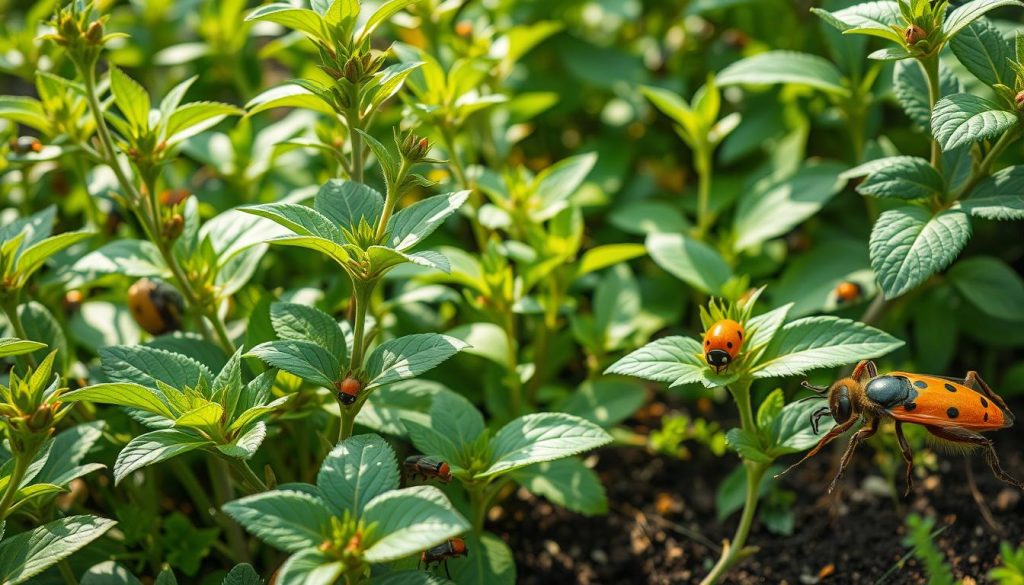
Understanding the importance of pest and disease management helps gardeners and farmers take steps to keep plants healthy. This includes watching plants for pests or diseases, using pest control services when needed, and using effective management strategies to prevent infestations.
| Type of Pest or Disease | Symptoms | Management Strategy |
|---|---|---|
| Aphids | Curled or distorted leaves | Use neem oil or insecticidal soap |
| Powdery Mildew | White powdery coating on leaves | Use fungicides or remove infected leaves |
| Spider Mites | Yellowing or bronzing of leaves | Use miticides or introduce natural predators |
Common Pests and Diseases in the U.S.
If you garden or farm in the United States, knowing common pests and diseases is key. Protecting your crops is vital to stop disease spread and pest infestations. Doing a thorough pest risk assessment helps spot threats and plan how to manage them.
Some common pests and diseases in the U.S. include:
- Aphids and whiteflies, which can spread plant viruses
- Fungal diseases like powdery mildew and rust, which harm leaves and stems
- Bacterial diseases like fire blight, which can kill plants
Invasive Species to Watch Out For
Invasive species can harm native plants by competing for resources and space. It’s important to know about invasive species in your area. Taking steps to stop their spread is crucial.
Seasonal Diseases Affecting Plants
Seasonal diseases like summer rot and winter frost can harm plants and lower yields. Knowing the seasonal diseases that affect your plants helps protect them. This ensures a healthy harvest.
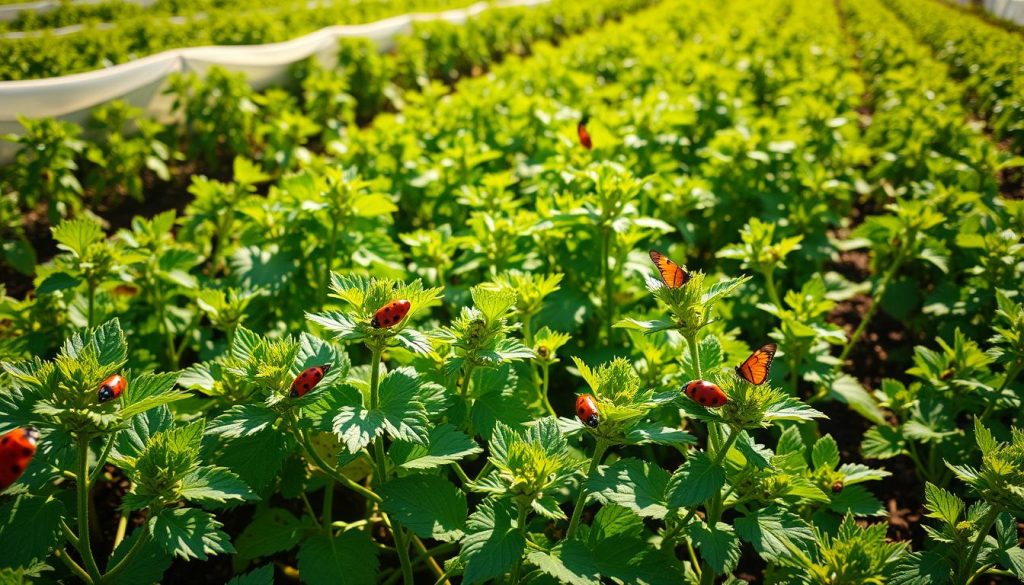
Integrated Pest Management (IPM)
As a gardener or farmer, managing pests and diseases is key for a healthy crop. Integrated Pest Management (IPM) is a great way to do this. It uses different methods to control pests and prevent diseases. Biological control, like using natural predators, is a big part of IPM.
It’s also important to keep an eye on pests. This lets me spot problems early and stop them before they get worse. Regular checks on my plants help me catch any signs of pests or diseases quickly.
Principles of IPM
- Identify the pest or disease
- Monitor the pest population
- Choose a control method (biological, cultural, or chemical)
- Evaluate the effectiveness of the control method
Benefits of Using IPM Strategies
IPM strategies have many advantages. They help reduce chemical use, improve crop yields, and make food safer. By managing pests in a holistic way, I can make my gardening or farming more sustainable and eco-friendly.
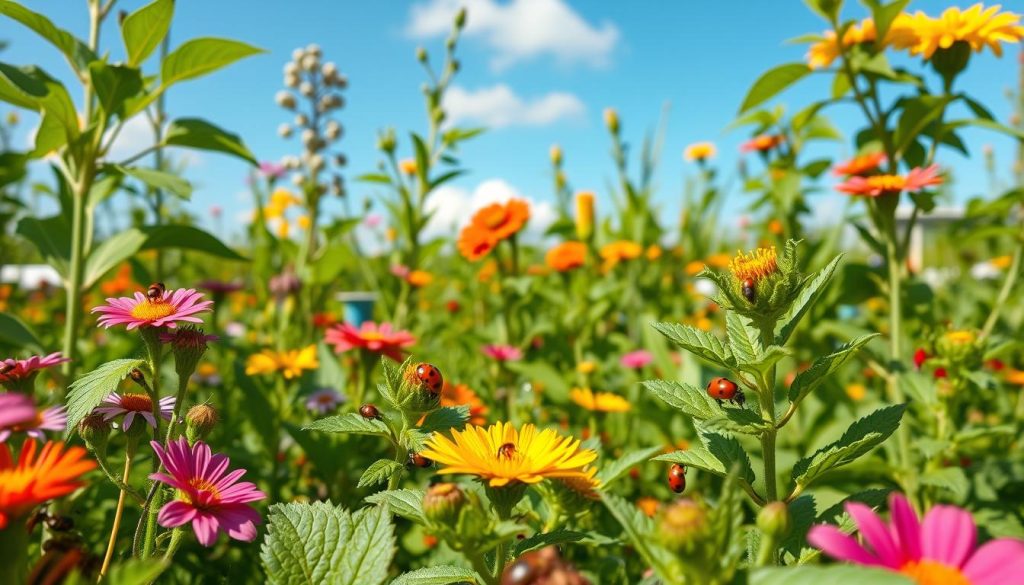
Natural Solutions for Pest Control
I’m excited to share natural ways to prevent disease and pests. Sustainable agriculture is key in this effort. It helps keep our environment healthy and pest-free.
Using sustainable methods makes our ecosystem stronger. It fights pests and diseases, helping our environment thrive.
Organic Pesticides: What to Use
There are many organic pesticides to choose from. Some top picks include:
- Neem oil
- Diatomaceous earth
- Soap solution
These options are good for the planet and work well. They’re perfect for those who want to farm sustainably.
Companion Planting Techniques
Companion planting is a smart way to control pests. It involves growing certain plants together. This method keeps pests away and helps plants grow strong.
For example, marigolds with tomatoes fight nematodes. Basil keeps aphids and other pests at bay. It’s a natural way to keep our environment healthy.
By using these natural methods, we can make our ecosystem better. Remember, disease prevention and sustainable farming are crucial for a healthy world.
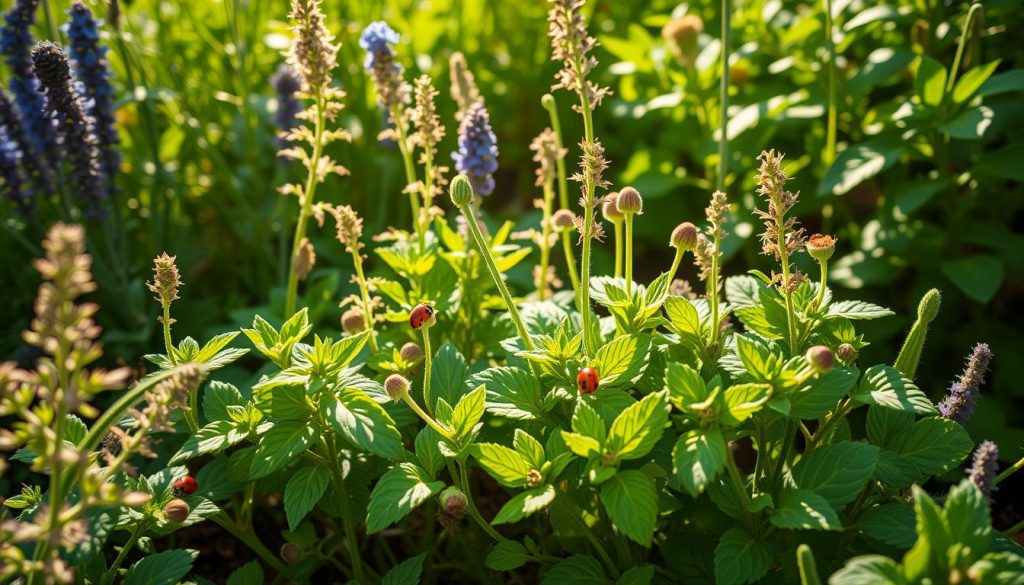
Chemical Alternatives: When to Use Them
Natural pest control is often the first choice. But sometimes, chemical pesticides are needed. It’s important to know the types of chemicals and how to use them safely.
Types of Chemical Pesticides
Chemical pesticides come in three main types: insecticides, herbicides, and fungicides. They can fight pests and diseases well. But, they can also be harmful if not used right.
Safety Precautions When Applying Chemicals
When using chemical pesticides, safety is key. Wear protective clothes, read the label, and use them in open spaces. Using a mix of methods, like cultural and biological controls, can also help. Pest control services can teach you how to use chemicals safely.
Using integrated pest management has many benefits:
- Less chemical use
- Less harm to the environment
- Better crop yields
Knowing about chemical pesticides and following safety steps helps us use them well. It also supports integrated pest management and pest control services.
| Type of Pesticide | Use | Safety Precaution |
|---|---|---|
| Insecticides | Control insects | Wear protective clothing |
| Herbicides | Control weeds | Read the label carefully |
| Fungicides | Control fungal diseases | Apply in well-ventilated areas |
Identifying Pests and Diseases Early
Early detection is key for managing pests and diseases. As a gardener or farmer, watching plant health closely is vital. This helps prevent disease outbreaks and keeps crops safe.
Signs and Symptoms to Look For
Look out for yellow or brown leaves, black spots, and white powdery patches. Also, listen for buzzing or chewing sounds. Spotting these signs early helps stop pests and diseases from spreading.
Tools for Pest and Disease Detection
Many tools can help find pests and diseases, like magnifying glasses and gardening handbooks. Online resources and traps are also useful. Regularly checking plant health with these tools ensures crops stay safe and healthy.
Cultural Control Practices
To manage pests and diseases well, we need to focus on cultural control. This means keeping the soil healthy for plants to grow well. A pest risk assessment helps spot threats and plan how to avoid them.
Crop rotation is a key way to keep soil healthy. It involves changing crops on the same land to stop pests and diseases. This method breaks disease and pest cycles, making it a vital part of biological control. Crop rotation helps create a balanced ecosystem that fights off pests and diseases better.
Some benefits of crop rotation include:
- Improved soil fertility and structure
- Reduced soil erosion
- Increased crop yields
- Enhanced biodiversity
By using cultural control like soil health and crop rotation, we can use fewer chemicals. Regular pest risk assessments and biological control help keep our growing spaces healthy and productive.
| Practice | Benefits |
|---|---|
| Soil Health Management | Improved soil fertility, reduced erosion |
| Crop Rotation | Increased crop yields, enhanced biodiversity |
| Pest Risk Assessment | Identification of potential threats, informed mitigation strategies |
| Biological Control | Reduced reliance on chemical pesticides, promotion of a balanced ecosystem |
Monitoring and Record Keeping
To manage pests and diseases well, tracking their presence is key. This is where pest monitoring and disease prevention are crucial. Regularly checking your plants and recording your findings helps spot issues early.
Keeping a pest and disease journal is a good idea. It’s just a notebook for noting the date, plants checked, and any pest or disease signs. You can also jot down weather, soil conditions, and treatments used.
Benefits of Record Keeping
- Early detection of pests and diseases
- Improved understanding of plant health
- More effective use of pest monitoring and disease prevention strategies
Looking at your data can reveal patterns and trends. This helps you make better decisions about pest and disease control. For instance, you might see that some plants get hit harder by pests or diseases. Or, you might find that certain weather leads to more outbreaks.
Best Practices for Record Keeping
To make your pest and disease journal useful, update it often and be detailed. Add photos, sketches, or other visuals to show your findings. Following these tips will help you use your journal to keep your plants healthy and growing well.
Recovering from Infestations
Dealing with pests and diseases in gardens or farms can be tough. But, with the right steps, you can fix plant health and stop future problems. In sustainable farming, controlling pests and diseases is key to a strong ecosystem.
There are many ways to treat plants hit by pests and diseases. You can use organic pesticides, introduce helpful insects, or change how you grow crops. For example, adding good bugs or switching up where you plant can lower the chance of more problems.
Treatment Options for Affected Plants
- Using organic pesticides, such as neem oil or insecticidal soap
- Implementing biological control methods, such as introducing beneficial insects
- Practicing cultural control methods, such as crop rotation and sanitation
Preventive Measures for Future Success
To avoid future problems, a complete approach to managing pests and diseases is needed. This means watching plant health closely, keeping soil healthy, and using green farming methods. These actions help lower the risk of pests and diseases and keep the ecosystem strong.
By using these methods, gardeners and farmers can overcome infestations and support sustainable farming. This not only keeps the ecosystem healthy but also helps their farming or gardening projects succeed in the long run.
Creating an Effective Pest Management Plan
As we’ve explored the many facets of
integrated pest management
and the benefits of
pest control services
, it’s time to take action. Develop your own personalized pest management strategy. By following a structured approach, you can ensure your garden or farm remains healthy and thriving for years to come.
Steps to Develop My Own Strategy
Start by conducting a thorough assessment of your property. Identify any existing pest or disease issues. Next, research the best organic and natural solutions that align with your goals.
Don’t be afraid to consult with local experts or utilize online resources to guide you. Remember, a successful pest management plan is an ongoing process. It requires vigilance and adaptability.
Resources for Ongoing Education and Support
The fight against pests and diseases is a continuous one, but you don’t have to go it alone. Seek out educational workshops, informative blogs, and trusted
pest control services
in your area. Stay up-to-date on the latest techniques and technologies. By staying informed and proactive, you’ll be well on your way to maintaining a healthy, thriving garden or farm for years to come.

